Isabel is about to graduate and a few weeks back she needed a few more community service hours to get a cord from the National Honors Society. The last Jake/Bull workday had been cancelled due to rain, so I coordinated with Debbie and Stan to get up there and do a little work with Iz this past Sunday.
There were 2 things that were high on the list: clearing lines of sight on the Jake Mountain trail, between the Moss Branch trail and Jones Creek, and filling in the geotextile that had been laid across a little Jones Creek feeder, just that side of Jones Creek proper.
Sounded good to us. We got right on it.
It rained on us the whole way up and it was storming around Cumming, but the forecast said that it would clear right about the time we ought to get there, so we kept our hopes up.
The weatherman was right, as it turned out, and it was barely drizzling when we got there.
The one thing we weren't sure of was the gate on 28B. It ought to be open, but no one knew for certain. If it hadn't been, we'd have had to walk in an extra mile or more, but it was, and we were thankful.
It was a quick walk to the singletrack, and the Moss Branch intersection is right there, so we got started immediately.

We basically cleared brush and lopped low branches around every curve, corner and switchback. The general idea is to make it possible to see someone coming around the curve or corner. If you can see someone coming, you can safely ride faster, or safely see someone else who's riding faster. It's good for faster moving mountain bikers to be able to see slower moving traffic coming the other way, as it's almost always necessary to yield to or communicate with the slower traffic. It's also good for horses to be able to see approaching traffic before it's immediately in front of them.
Here's kind-of an illustration of what we did.
Before:
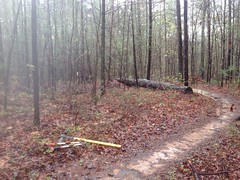
(Isabel's sleeve is that white speck left of center)
After:

Unfortunately, Iz took off her jacket, and was standing slightly to the right in the second photo, so it's not a perfect illustration. But, that's how it was before and after - that kind of difference at that kind of distance.
We ran into a couple of cool things while we were working.
Iz found this weird growth on a blackberry bush.
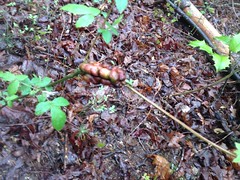
And there was also a small scorpion under a rock on the trail.
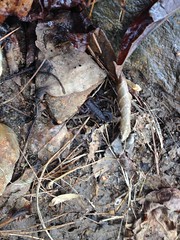
Makes you wonder how many thousands of them you walk or ride by every day.
Also, it alternately drizzled, rained for real, and cleared up, like 4 different times while we worked. We never got super wet, but it always seemed like we were about to right before it stopped raining.
We eventually got down to the geotextile, which was, fortuitously, right where we needed to stop lopping.
Before:
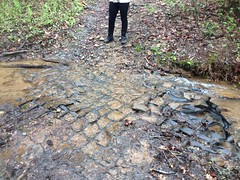
It took me a minute to figure out why we were doing anything. The geotextile is exposed, but it was still holding a ton of rock and gravel, from about ten feet from the creek, all the way across it, and up the other side. It appeared to still be completely functional, at least in preventing impact from users crossing the creek.
But wait!
It eventually dawned on me... When the textile gets exposed, it's super easy for hooves (and feet for that matter) to get caught in it, especially where it's underwater. I remembered someone mentioning that 10+ years ago in one of those trail maintenance classes.
Ok, ok, ok. Got it.
We started by filling it with medium sized, chunky rock, and bigger rocks downstream of the crossing.

These rocks were provided by the little creek itself. Just upstream was an inexhaustible trove of them. We had to do this relay though, where we'd throw the rocks into a pile 10 or 20 feet downstream, then throw that whole pile another 10 or 20 feet downstream again, then chuck them onto the geotextile, and finally place them carefully when we had a big enough pile going.
Then, we dug up gravel from various little gravel bars downstream of the crossing, piled it onto my jacket, hauled it back up to the crossing, and spread it all over to fill in between the rocks.
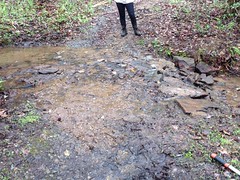
That step was backbreaking. First, we'd only brought loppers, a pulaski, and a saw with us. No shovel. My kingdom for a shovel! Also, even if we'd had a shovel, we still would have had to use the jacket to transport the gravel. One shovel-load at a time would have taken forever. But, it was like 100 pounds of gravel each time, over rough, rocky, rooty, and brushy terrain. And, it took 6 loads of gravel to cover the crossing.
There was a bit still exposed uphill to the north, but we couldn't come up with a decent strategy for filling it.

We eventually tried trimming it, but the loppers weren't up to the task. I remember saying that I wished I had a box cutter. I'm an idiot though, because I had a knife, with a half-smooth/half-serrated blade, dangling off of my camelback, at the time. No idea why I didn't remember it at the time, but I didn't. Maybe next time I will.
The hike out was mostly uphill and seemed a lot longer than the hike in. Whooo! I'd also packed the jacket that we used to tote the gravel in my camelback, but it was still super wet from having been washed in the creek after every load, and it dripped water down the back of my pants all the way out, which was just maddeningly uncomfortable. I eventually took it out, put the hood over my head, and draped it over my pack. This helped a little. Rather than dripping down at my waist, it dripped down at the backs of my knees. Dealing with the drippy jacket was by far the toughest part of the day.
One more thing worth mentioning...
When we arrived, we ran through the Jake lot to hit the port-a-potty, and there was a guy parking his motorcycle trailer there at the time. I didn't think anything of it, as we regularly see people trailer their bikes there and hit the forest roads nearby. I've seen that like 10 times.
About halfway between Moss and Jones Creek though, we heard a guy approaching on a motorcycle. Again, I didn't think anything of it at first, he could be over on FS28-1. He did sound close though, and it turned out he was riding on the Jake Mountain trail...
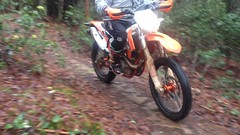
...which is decidedly against the rules. Debbie and Stan mentioned that they'd either seen tracks, or heard secondhand of them, but I'd never seen it myself until that day.
It's tough to be too critical of the guy though. On the one hand, he's breaking the rules, and in doing so not respecting the design, maintenance, or user experience goals of the trail. On the other hand, the guy seemed to be riding with a specific goal of minimizing impact. When he came up on us, he was riding at mountain bike pace, waved, waited for me to wave him through, and mentioned: "I'll keep it quiet..." which I took to mean keep his engine quiet and pace down. Walking the length of the trail after he came through and keeping an eye out for impact, I can't say that there was any to speak of. There were tire tracks in the deposition at the bottoms of some of the grade reversals, but the displacement was only marginally worse than that of our own footprints, and that soil is destined to be cleaned out anyway. I guess that says a lot about the trail design, but it also says a lot about how conscientious he was.
It made me think a bit about motorcycles on multi-use singletrack. Logistically, why couldn't a conscientious guy on a motorcycle ride the Bull and Jake trails? I'd be curious to compare soil shearing on clay between horses and motorcycles on a 10-15% grade climb. I'd also be curious to see how feasible it is for a motorcycle to yield to a horse by getting off trail on the downside. I suspect that would be tricky, and do some damage getting back on, but I don't know. I'd have to see it. I'd also be curious to see the impact of crossing a creek like Jones Creek. Mountain bikers have to walk it, and carry our bikes up and down the banks. Motorcycles can't be carried like that, but I'd have to see how managing it compares to a horse or hiker. Otherwise I couldn't think of any logistical problems.
Of course, ultimately, conscientious use can't be expected. Trails just have to be designed to take what the least conscientious user can give. So, motorized trails generally need to be wide enough to be maintained with motorized equipment and kept away from the watershed. I guess that's unfortunate for the rider who knows what he's doing.
All that said, it's against the rules, and there's been a bit of it lately, so we're going to put up some signs, kindly requesting that people don't ride motorized vehicles on the Bull/Jake trails, and see how it goes.
I do feel bad about putting that's guy's photo on the sign though. It kind-of vilifies the wrong guy. It's the only photo I've got, so it's the only one I can use, but I can't honestly say, personally, that I'd mind sharing the trail with him.



No comments:
Post a Comment